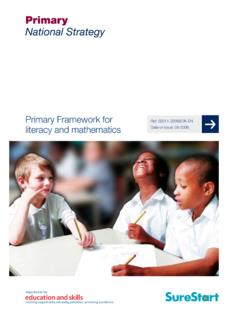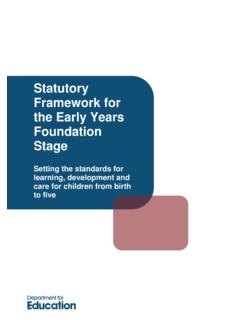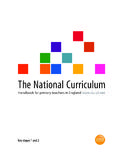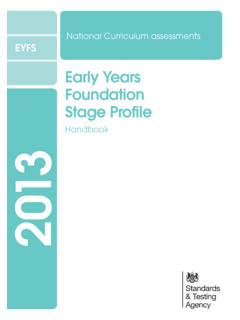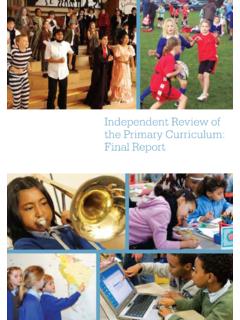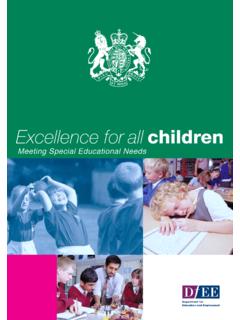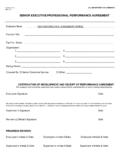Transcription of 14-19 Curriculum and Qualifications Reform
1 Curriculum and Qualifications Reform Final Report of the Working Group on 14-19 ReformOctober 20041It is with pleasure that I present to you the report of the Working Group set up byMinisters to advise on Reform of Curriculum and assessment arrangements for 14 to 19 year is our view that the status quo is not an option. Nor do we believe further piecemealchanges are desirable. Too many young people leave education lacking basic andpersonal skills; our vocational provision is too fragmented; the burden of externalassessment on learners, teachers and lecturers is too great; and our system is notproviding the stretch and challenge needed, particularly for high attainers. The resultsare a low staying-on rate post-16; employers having to spend large sums of money toteach the basics ;HE struggling to differentiate between top performers; and youngpeople s motivation and engagement with education reducing as they move throughthe report sets out a clear vision for a unified framework of 14-19 Curriculum andqualifications.
2 We want scholarship in subjects to be given room to flourish and wewant high quality vocational provision to be available from age 14. These aredifferent, but both, in their own terms, are vital to the future wellbeing of young peopleand hence our country. We want to bring back a passion for learning, and enable alllearners to achieve as highly as possible and for their achievements to be recognised. We must ensure rigour and that all young people are equipped with theknowledge, skills and attributes needed for HE, employment and adult its weaknesses, the current system has its strengths. Many elements of thereforms we propose can already be found in schools and colleges around the countryand we want to build on their good practice. We also wish to retain the best featuresof existing Qualifications and particularly the well-established GCSE and A level they would not be available as separate Qualifications , GCSEs and A levels andgood vocational Qualifications would become components ,which form the buildingblocks of the new should be a managed evolution and not a revolution.
3 It is vital that allstakeholders are involved in the detailed work necessary and that all decisions areinformed by sound evidence borne out of careful piloting and modelling. Teachers,lecturers and trainers will need support throughout and their experience drawn , governors and young people should be kept fully informed and the credibilityof the current Qualifications protected through the period of Group on 14-19 ReformLevel 1 Caxton HouseTothill StreetLondonSW1H 9 NAMike TomlinsonChairman18 October 2004 The Rt Hon Charles Clarke MPDepartmant for Education and SkillsSecretary of State for Education and SkillsRoom BuildingsGreat Smith StreetLondon SW1P 3BT14-19 Curriculum and Qualifications ReformFinal Report of the Working Group on 14-19 ReformI commend this report to you and in doing so wish to place on record my sincerethanks to members of the Working Group, the various sub-groups, the associatenetwork members and officials.
4 Their unstinting support has been key, as has theactive involvement of employers, higher education, teachers, lecturers, trainers,parents and young people in our work. A particular thanks is owed to the secretariatsupporting the Working Group, so ably led by Matthew believe there exists substantial consensus about the need for Reform and broadproposals set out. We believe they satisfy your five tests and look forward to theGovernment s response in due sincerelyMike Tomlinson2 ContentsExecutive summary and summary of recommendations401 Introduction16 Chapter 1 Introduction1602 A unified framework for 14-19 learning20 Chapter 2 Programmes and diplomas20 Chapter 3 Core and main learning29 Chapter 4 Diploma volume, thresholds and progression45 Chapter 5 Meeting the needs of different learners entry, foundation.
5 Intermediate and advanced programmes and diplomas51 Chapter 6 Assessing the diploma57 Chapter 7 Grading and reporting achievement6903 Themes76 Chapter 8 Strengthening the vocational offer76 Chapter 9 Reducing the assessment burden85 Chapter 10 Stretch and challenge90 Chapter 11 Raising participation and tackling disengagement92 Chapter 12 Quality of learning and teaching95 Chapter 13 Entering and leaving 14-19 learning providing a coherent experience for learners and meeting the needs of end-users9704 Delivering the new system102 Chapter 14 Quality assurance of the new system102 Chapter 15A supportive infrastructure106 Chapter 16 Implementation1103 Why is Reform needed? report sets out our proposals and recommendations forreforming 14-19 Curriculum and Qualifications , building on strengthswithin the current system while addressing its weaknesses, to: Raise participation and achievement by tackling theeducational causes of disengagement and underachievement andlow post-16 participation.
6 Get the basics right ensuring that young people achievespecified levels in functional mathematics, literacy andcommunication and ICT, and are equipped with the knowledge,skills and attributes needed to succeed in adult life, furtherlearning and employment. Strengthen vocational routes improving the quality and statusof vocational programmes delivered by schools, colleges andtraining providers, setting out the features of high quality provisionand identifying a clear role for employers. Provide greater stretch and challenge ensuring opportunitiesfor greater breadth and depth of learning. This will help employersand universities to differentiate more effectively between topperformers. Stretch and challenge at all levels will encourageyoung people to think for themselves and be innovative andcreative about their learning.
7 Reduce the assessment burdenfor learners, teachers,institutions and the system as a whole by reducing the number of times learners are examined; extending the role of teacherassessment; and changing assessment in A levels in order toimprove the quality of teaching and learning. Make the system more transparent and easier to understandby rationalising 14-19 Curriculum and Qualifications within adiploma framework, where progression routes and the value ofqualifications are summaryand summary ofrecommendations14-19 Curriculum and Qualifications ReformFinal Report of the Working Group on 14-19 young person should be able to develop her/his full potential, and becomeequipped with the knowledge, skills and attributes needed for adult life. This includespreparation for work to which they are well suited, development of positive attitudes tocontinuing learning and active participation within the proposals centre on two linked developments: a common format for all 14-19 learning programmes which combine the knowledgeand skills everybody needs for participation in a full adult life with disciplines chosenby the learner to meet her/his own interests, aptitudes and ambitions; and a unified framework of diplomas which: provide a ready-made, easy to understandguarantee of the level and breadth of attainment achieved by each young person,whatever the nature of his or her programme; offer clear and transparent pathwaysthrough the 14-19 phase and progression into further and higher learning, trainingand employment.
8 Are valued by employers and HE; and motivate young people tostay on in learning after the age of new framework for 14-19 14-19 year olds should have access to coherent and relevant learningprogrammes. These should comprise: core learningwhich is about getting the basics right, and developing the genericknowledge, skills and attributes necessary for participation in higher education,working life and the community; and main learning chosen by the learner to develop knowledge, skills andunderstanding of academic and vocational subjects and disciplines which provide a basis for work-based training, higher education and 14-16 year olds, the programme will also include the Key Stage 4 statutoryNational Curriculum , which lays the basis for core learning and can also contributetowards main major feature of our proposals is the inclusion of an extended projectas partof core learning.
9 Selected by the young person to pursue her/his interests and extendher/his learning in creative and innovative ways, it may take a variety of forms from anessay to a performance or artefact. Its completion will enable learners to develop anddemonstrate a range of generic skills, such as problem solving, research andmanaging own Curriculum and Qualifications ReformFinal Report of the Working Group on 14-19 that achievement within 14-19 programmes should be certified bydiplomas available at the first four levels of the National Qualifications Framework, and using a credit system compatible with that being developed by QCA for adultqualifications. Diplomas at successive levels would overlap, so that achievement atone level would provide the basis for progression to, and achievement at, the diplomas would be named based on the lines of learning they relate to.
10 Oneline would recognise achievement in open programmes, where learners can choosea mixture of subjects and/or vocational options from different lines. The remaining lineswould provide more specialised named pathways, covering broad academic andvocational recommendations: coherent programmesAll 14-19 programmes should comprise core and main learning should ensure: specified levels of achievement in functional mathematics, functional literacyand communication, ICT; completion of an extended project appropriate to the level of the diploma; development of a range of common knowledge, skills and attributes (CKSA),such as personal awareness, problem solving, creativity, team-working andmoral and ethical awareness; an entitlement to wider activities; and support for learners in planning and reviewing their learning, and guidance inmaking choices about further learning and 14-16 year olds should continue to follow the statutory National Curriculum atKey Stage 4 and other statutory Curriculum recommendations: the diploma frameworkThe existing system of Qualifications taken by 14-19 year olds should be replacedby a framework of diplomas at entry, foundation, intermediate and advancedlevels.

